Portuguese India: from the journey of Vasco da Gama to the colonial Goa
Portuguese sea expansion
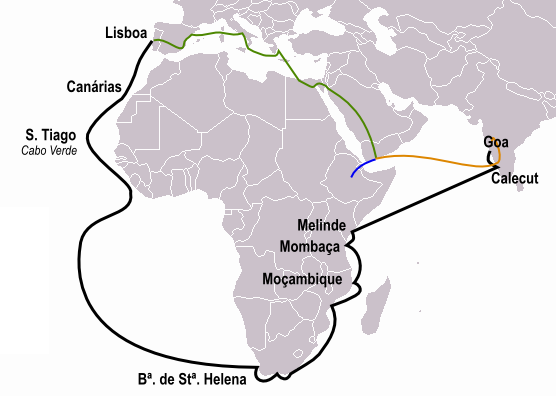 One of the reasons that prompted Portugal to expand into overseas lands was a small area of the state, which limited the possibilities for the economic and socio-demographic development of the country. Portugal had a land border only with a stronger Spain, with which she simply had no opportunity to try to expand her territory. On the other hand, the appetites of the Portuguese political and economic elite in the XV-XVI centuries. increased significantly. Realizing that the only way to turn a country into a strong state with strong positions in world politics and economics is sea expansion with the establishment of a monopoly in trade in certain goods and the creation of strongholds and colonies in the most significant regions for overseas trade, the Portuguese elite began to prepare expeditions in search of a sea route to India. The beginning of the Portuguese colonial conquest is associated with the name of Prince Enrique (1394-1460), which went down in history as Henry the Navigator.
One of the reasons that prompted Portugal to expand into overseas lands was a small area of the state, which limited the possibilities for the economic and socio-demographic development of the country. Portugal had a land border only with a stronger Spain, with which she simply had no opportunity to try to expand her territory. On the other hand, the appetites of the Portuguese political and economic elite in the XV-XVI centuries. increased significantly. Realizing that the only way to turn a country into a strong state with strong positions in world politics and economics is sea expansion with the establishment of a monopoly in trade in certain goods and the creation of strongholds and colonies in the most significant regions for overseas trade, the Portuguese elite began to prepare expeditions in search of a sea route to India. The beginning of the Portuguese colonial conquest is associated with the name of Prince Enrique (1394-1460), which went down in history as Henry the Navigator.With his direct participation in 1415, Ceuta was taken - an important commercial and cultural center of North Africa, which at that time was part of the Moroccan state of the Wattasids. The victory of the Portuguese troops over the Moroccans opened the page of the centuries-old colonial expansion of Portugal in the southern seas. Firstly, for Portugal, the conquest of Ceuta was sacred, because in this battle the Christian world, with which Lisbon personified itself, defeated the Muslims of North Africa, who had not so long ago dominated the Iberian Peninsula. Secondly, the appearance of an outpost on the territory of modern Morocco opened to the Portuguese the fleet further way to the southern seas. In fact, it was the capture of Ceuta that marked the beginning of the era of colonial conquest, in which, after Portugal and Spain, almost all the more or less developed European states took part.
After the capture of Ceuta began sending Portuguese expeditions to search for a sea route to India, leading to bypassing the African continent. From 1419, Heinrich the Navigator sent the Portuguese ships, which gradually moved further south and south. Azores, Madeira, Cape Verde - the first in the list of acquisitions of the Portuguese crown. On the West African coast, the creation of Portuguese outposts began, almost immediately discovering such a profitable source of income as trade in slaves. "Living goods" was originally exported to Europe. In 1452, Mr. Nicholas V, the then Pope, allowed the Portuguese crown a colonial expansion in Africa and slave trade with a special bull. However, until the end of the 15th century, no further serious changes were observed in Portugal’s maritime route to India. Some of the stagnation was promoted: firstly, the defeat near Tangier in 1437, which the Portuguese troops suffered from the army of the Moroccan sultan, and secondly, the death of Henry the Navigator, who was a key figure in the organization of marine expeditions of the Portuguese crown, in 1460 for a long time. However, at the turn of the XV-XVI centuries. Portuguese sea expeditions in the southern seas again intensified. In 1488, Bartolomeu Dias discovered the Cape of Good Hope, originally called the Cape of Storms. This was the most serious advance of the Portuguese towards the discovery of the sea route to India, because after 9 years - in 1497 - another Portuguese navigator Vasco da Gama still skirted the cape of Good Hope.
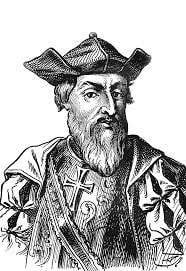
The Vasco da Gama expedition violated the trade and political order that had existed for several centuries in the Indian Ocean. By this time, Muslim sultanates existed on the East African coast, on the territory of modern Mozambique, Tanzania, Kenya, Somalia, and maintained close relations with the Arab world. Transoceanic trade was carried out between the East African coast, the ports of the Persian Gulf and Western India. Naturally, the sudden appearance of such a new and very dangerous factor here as European seafarers did not cause a positive reaction from the local Muslim rulers. Especially considering the fact that the trading routes in the Indian Ocean in the period under review were controlled by Arab traders from Muscat and Ormuz, who absolutely did not want to see new rivals in their sphere of influence.
The fleet of Vasco da Gama subjected to shelling from the guns of the village on the coast of modern Mozambique, in the Mombasa region (modern Kenya), captured and plundered the Arab merchant ship, taking prisoners around 30 Arab sailors. However, in the city of Malindi, whose sheikh was in hostile relations with the ruler of Mombasa, Vasco da Gama met a good reception. Moreover, here he found an experienced Arab pilot who led his ship through the Indian Ocean. 20 May 1498 The ships of the Vasco da Gama flotilla approached the Indian city of Calicut on the Malabar coast (now Kozhikode, Kerala, Southwestern India). Vasco da Gama was initially greeted with honor by the local ruler, who bore the title of “Zamorin”. Zamorin Calicut held a parade of three thousand troops in honor of the arriving Europeans. However, Zamorin soon became disillusioned with the Portuguese envoy, which was aided, firstly, by the influence of Arab merchants, and secondly, by dissatisfaction with gifts and goods brought from Europe for sale. The European navigator arrived in the spirit of an ordinary pirate - departing from Calicut, the Portuguese abducted about twenty local fishermen with the aim of turning them into slavery.
Calicut-Portuguese War
Nevertheless, Vasco da Gama’s journey reached its goal - a sea route to India was found. The goods brought to Portugal repeatedly exceeded the cost of Lisbon’s expedition equipment. It remained to consolidate its influence in the Indian Ocean, on which the Portuguese government focused its efforts in the first decade of the 16th century. In 1500, the 2 of the Indian Indian Armada of Portugal, commanded by Pedro Alvares Cabral, followed. 9 March 1500 of the year Cabral, at the head of a flotilla of 13 ships and 1200 sailors and soldiers, sailed from Lisbon, but went astray and reached the shores of modern Brazil. 24 April 1500 g. He landed on the Brazilian coast and declared the coastal strip of the territory of Portugal called "Vera Cruz". Sending one of the captains to Lisbon with an urgent dispatch to the king on the opening of a new overseas possession, Cabral resumed the sea route to India. In September 1500, the Cabral fleet arrived in Calicut. The new Zamorin was ruled here by Manivikraman Raja, who accepted the gifts of the Portuguese king and authorized the creation of a Portuguese trading post on the Malabar coast. Thus, the first Portuguese outpost in the Indian subcontinent appeared.
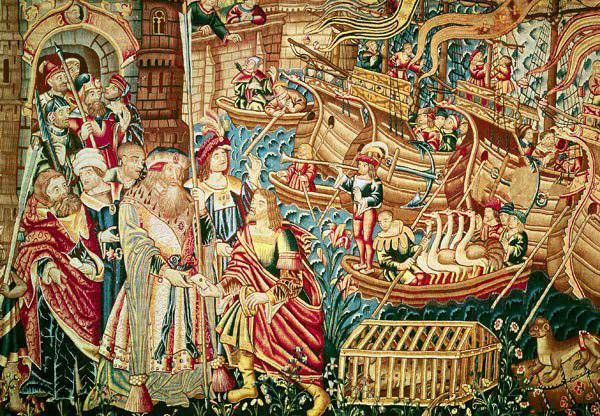
However, the creation of a Portuguese trading post in Calicut was extremely negatively received by local Arab merchants, who previously controlled all Indian trans-ocean trade. They began to use tactics of sabotage and the Portuguese were unable to fully load the ships to be shipped to Lisbon. In December 17 responded to Cabral seized an Arab ship with spices, about to sail from Calicut to Jeddah. The reaction of the Arab merchants followed immediately - a crowd of Arabs and local residents attacked the trading station. Killed from 50 to 70 (according to various sources) of the Portuguese, the rest managed to escape and fled to Portuguese ships stationed in the port. As a sign of revenge Cabral captured ten Arab ships in the port of Calicut, killed all the merchants and sailors on board. The goods that were on the ships were seized by the Portuguese, and the Arab ships themselves were burned. After that, the Portuguese flotilla opened fire from ship guns at Calicut. The shelling went on all day and as a result of the punitive action at least about six hundred local civilians were killed.
24 December 1500, after completing a punitive operation in Calicut, Cabral sailed to Cochin (now Kerala, South-West India). Here was created a new Portuguese trading post on the Indian coast. It is noteworthy that in Cochin, from the beginning of our era, there was a fairly active community of local Kochi Jews - descendants of migrants from the Middle East, partially assimilated with the local population and switched to a special language "Judeo-Malayalam", which is a Judaized version of the Dravidian language Malayalam. The opening of the Portuguese trading post on the Malabar coast led to the fact that European, more precisely Pyrenean, Sephardic Jews who escaped from persecution in Portugal and Spain appeared here. Having established contacts with the local community, who called them "parjeshi" - "strangers", the Sephardi also began to play an important role in maritime trade with Portugal.
The opening of the trading post in Cochin was followed by the expansion of the Portuguese colonial expansion in the Indian Ocean. In 1502, the Portuguese king Manuel outfitted a re-expedition to India under Vasco da Gama. 10 February 1502 from Lisbon exited 20 ships. This time, Vasco da Gama acted even more harshly against the Arab merchants, because he had a goal in every possible way to hinder the trans-Ocean trade of the Arabs. The Portuguese founded forts in Sofal and Mozambique, subjugated Emil Kilwa, and also destroyed an Arab vessel with Muslim pilgrims on board. In October, 1502 Armada da Gama arrived in India. In Kannanur, the second Portuguese trading post was laid on the Malabar coast. Then da Gama continued the war begun by Cabral against the Zamorin Calicut. The Portuguese flotilla bombarded the city with naval guns, turning it into ruins. The captured Indians were hanged on the masts, some were cut off by their arms, legs, and heads, sending the dismembered bodies to a freeze. The latter preferred to flee the city. The flotilla of foreigners assembled with the help of Arab merchants was almost immediately crushed by the Portuguese, whose ships were equipped with artillery.
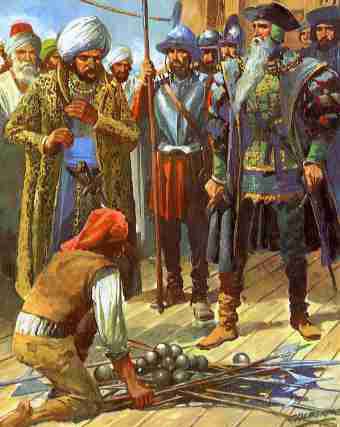 Thus, the beginning of the Portuguese presence in India was immediately marked by a war with the local state of Calicut and violence against civilians. However, the rajas of other Malabar cities that competed with Calicut’s zamorino preferred to cooperate with the Portuguese, allowing them to build their trading posts and trade on the coast. At the same time, the Portuguese made themselves and powerful enemies in the face of Arab merchants, who previously had almost monopolistic positions in the transoceanic trade in spices and other scarce goods, brought from the islands of the Malay Archipelago and from India to the ports of the Persian Gulf. In 1505, the position of the Vice-King of India was established by King Manuel of Portugal. Thus, Portugal actually declared its right to own the most important ports on the west coast of Hindustan.
Thus, the beginning of the Portuguese presence in India was immediately marked by a war with the local state of Calicut and violence against civilians. However, the rajas of other Malabar cities that competed with Calicut’s zamorino preferred to cooperate with the Portuguese, allowing them to build their trading posts and trade on the coast. At the same time, the Portuguese made themselves and powerful enemies in the face of Arab merchants, who previously had almost monopolistic positions in the transoceanic trade in spices and other scarce goods, brought from the islands of the Malay Archipelago and from India to the ports of the Persian Gulf. In 1505, the position of the Vice-King of India was established by King Manuel of Portugal. Thus, Portugal actually declared its right to own the most important ports on the west coast of Hindustan. 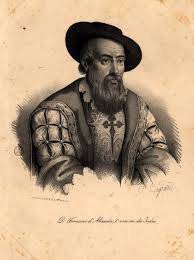 The first Indian viceroy was Francisco de Almeida (1450-1510). His cousin was married to Vasco da Gama, and di Almeida himself belonged to a noble Portuguese aristocratic surname, dating back to the dukes of Cadaval. Di Almeida's youth passed in wars with Moroccans. In March, 1505, he headed the flotilla from the ship 21 was sent to India, the vice-king of which he was appointed King Manuel. It was Almeida who proceeded to the systematic establishment of Portuguese rule on the Indian coast, creating a number of fortified forts in Kannanur and Anjadiv, and also on the East African coast in Kilwa. Among the “destructive” actions of Almeida are the shelling of Mombasa and Zanzibar, the destruction of Arab trading posts in East Africa.
The first Indian viceroy was Francisco de Almeida (1450-1510). His cousin was married to Vasco da Gama, and di Almeida himself belonged to a noble Portuguese aristocratic surname, dating back to the dukes of Cadaval. Di Almeida's youth passed in wars with Moroccans. In March, 1505, he headed the flotilla from the ship 21 was sent to India, the vice-king of which he was appointed King Manuel. It was Almeida who proceeded to the systematic establishment of Portuguese rule on the Indian coast, creating a number of fortified forts in Kannanur and Anjadiv, and also on the East African coast in Kilwa. Among the “destructive” actions of Almeida are the shelling of Mombasa and Zanzibar, the destruction of Arab trading posts in East Africa. Portuguese-egyptian naval war
The policy of Portugal in India and the presence of the Portuguese in the Indian Ocean contributed to the growth of anti-Portuguese sentiment in the Muslim world. Arab merchants, whose financial interests directly suffered as a result of the actions of the Portuguese conquerors, complained about the behavior of the Franks to the Muslim rulers of the Middle East, paying particular attention to the great danger of the very fact that Christians in the region were claiming Islam and the Islamic world. On the other hand, the Ottoman Empire and the Mamluk Sultanate of Egypt, through which the main flows of spices and other scarce goods from the southern countries passed through the Indian Ocean, also suffered significant losses due to the actions of Portugal.
Venice was on the side of the Turks and the Mamluks. This Italian trade republic, which played an important role in the Mediterranean trade, also had close contact with the Muslim world and was one of the links in the supply chain of overseas goods from India to Europe through Egypt and Asia Minor. Therefore, the Venetian trade circles, who did not dare to go into open conflict with Portugal, all the more fearful of quarreling with the Catholic world as a whole, exposing themselves as supporters of Muslims, acted through hidden influence on the Turkish and Egyptian sultans. Moreover, Venice provided financial and technical assistance to the Egyptian Mamluks in the creation and equipment of the military fleet.
The first among the Muslim rulers of the Middle East on the behavior of the Portuguese Egyptian Mamluks reacted. In 1504, the sultan Kanukh al-Gauri demanded that the Pope immediately influence the Portuguese naval and trading activities in the Indian Ocean. In case the Pope does not provide support to the Sultan and does not put pressure on Lisbon, the Sultan promised to begin the persecution of the Coptic Christian community in Egypt, and then destroy Christian monasteries and churches in Palestine. For greater conviction, the head of the Sinai Monastery was appointed as head of the embassy. At the same time, the Venetian embassy of Francesco Teldi visited Cairo, who advised Sultan Kansuh al-Gauri to sever trade and diplomatic relations with the Portuguese and enter into a military alliance with the Indian rulers who suffered from the actions of the Portuguese armadas, above all with Calicut.
In the next 1505, the sultan Kansukh al-Gauri, following the advice of the Venetian embassy and the Arab merchants, created an expeditionary fleet against the Portuguese. With the help of the Ottoman Empire and Venice, the flotilla under the command of Amir Hussein al-Kurdi was equipped. The construction of the ships was provided by the Venetian merchants, who supplied timber from the Black Sea region to Alexandria. Then the forest was transported by caravans to Suez, where ships were being built under the guidance of Venetian specialists. Initially, the flotilla consisted of six large ships and six galleys with 1500 soldiers on board. At the headquarters of Amir al-Kurdi, who served as governor of Jeddah, was the ambassador of the calicut Calicut Mehmed Markar. In November, 1505 fleet sailed from Suez to Jeddah, and then to Aden. It should be noted here that the Mamluks, who were strong in cavalry battles, were never prone to navigation and were poorly understood in the maritime business; therefore, without the involvement of Venetian advisers and engineers, the creation of the Mamluk fleet would hardly be possible.
Meanwhile, in March 1506, Calicut's navy was defeated by the Portuguese at the port of Kannanur. After that, the Californian troops launched a land attack on Kannanur, but for four months they could not take the city, after which the assault was repulsed by the Portuguese squadron from the island of Socotra that arrived in time. In 1507, the Mamluk fleet of Amir al-Qurdi advanced to help Calicut. In conjunction with the Mamluks, the Sultan of Gujarat spoke, possessing the largest fleet in Western India, commanded by the governor of the city of Diu Mameluk Malik Ayaz. The reasons for the entry of the Sultanate of Gujarat into the war with the Portuguese also lay on the surface - the sultan conducted the main trade through Egypt and the Ottoman Empire and the appearance of the Portuguese fleet in the Indian Ocean reduced its financial well-being.
In March, 1508, in the Chaula Bay, a flotilla of the Mamluk Egypt and the Sultanate of Gujarat, engaged the Portuguese fleet, commanded by Lawrence de Almeida, the son of the first viceroy of India, Francisco de Almeida. A major naval battle lasted two days. Since the Mamluks and Gujaratis greatly outnumbered the Portuguese in the number of ships, the outcome of the battle was predetermined. The Portuguese flagship, commanded by Lawrence de Almeida, was sunk at the entrance to the Bay of Chaula. The Portuguese suffered a crushing defeat. Of the Portuguese ships 8, who participated in the sea battle, only two managed to escape. The Mamluko-Gujarati flotilla returned to the port of Diu. However, the Portuguese did not abandon their further plans to conquer India. Moreover, taking revenge for the viceroy Francisco de Almeida was a matter of honor, since his son Lawrence was killed in the battle of Chaula.
3 February 1509 of the city of Diu held a re-sea battle of the Portuguese armada against the Egyptian-Indian fleet of the Mamluk sultanate, the sultanate of Gujarat and Calicut submarine. The Portuguese fleet was commanded personally by the viceroy Francisco de Almeida. This time the Portuguese caravels, equipped with artillery, were able to prevail over the Egyptian-Indian coalition. Mamluks were defeated. Wishing to avenge the death of his son, Francisco de Almeida ordered to hang up all the prisoners from among the Mamluk, Gujarati and Kalukta sailors. Victory in the battle of Diu actually put the main sea routes in the Indian Ocean under the control of the Portuguese fleet. Following the victory off the coast of India, the Portuguese decided to move on to further actions to level the Arab influence in the region.
In November, 1509, Mr. Francisco de Almeida, who was retired from his post as viceroy and transferred to the new viceroy Afonso de Albuquerque, traveled to Portugal. In the area of present-day Cape Town off the coast of South Africa, Portuguese ships moored in Table Mountain Bay. 1 March 1510, a detachment led by di Almeida set off to replenish drinking water supplies, but was attacked by local natives of the Hottentots. The sixty-year-old first viceroy of Portuguese India died in a clash.
Creation of Portuguese India
Afonso de Albuquerque (1453-1515), who replaced Almeida as viceroy of Portuguese India, also came from a noble Portuguese family. His grandfather and paternal grandfather served as trusted secretaries of the Portuguese kings, João I and Duarte I, and his maternal grandfather was an admiral of the Portuguese navy. From his early years, Albuquerque began his service in the Portuguese army and navy, participated in North African campaigns, in the capture of Tangier and Asila. Then he participated in the expedition to Cochin, in 1506, he took part in the expedition of Tristan da Cunha. In August, Albuquerque’s 1507 founded a Portuguese fort on Socotra Island, and then directly led the assault and seizure of Hormuz, a strategic point at the entrance to the Persian Gulf, which gave the Portuguese unlimited opportunities to establish control over Indian Ocean trade and trade. between India and the Middle East, through the ports of the Persian Gulf.
In 1510, it was Afonso de Albuquerque who led Portugal’s next major colonial operation in the Indian subcontinent — the conquest of Goa. Goa was a major city on the west coast of Hindustan, much north of the Portuguese trading posts on the Malabar coast. By the time described Goa was controlled by Yusuf Adil-Shah, who later became the founder of the Bijapur Sultanate. The Portuguese attack on Goa was preceded by a request for help from local Hindus, who were not satisfied with Muslim rule in the city and region. Hindu rajas have long been hostile to the Muslim sultans and perceived the Portuguese as desirable allies in the fight against their long-time adversary.
Raja Timmarusu, who formerly ruled Goa, but was expelled from there by Muslim rulers, hoped to regain his authority over the city with the help of Portuguese troops. February 13 on the advice of the captains of the Portuguese fleet, it was decided to storm Goa and February 28 Portuguese ships entered the mouth of the Mandovi river. First of all, the Portuguese captured Fort Panjim, whose garrison did not resist the conquerors. After the capture of Panjim, the Muslim population left Goa, and the Hindus met the Portuguese and solemnly handed the keys to the city to the Vice-King of Albuquerque. The commandant of Goa was appointed Admiral Antonio de Noronha.
However, the joy of the easy and virtually bloodless conquest of such a large city was premature. Yusuf Adil-Shah at the head of 60-thousandth Muslim army 17 May approached Goa. He offered the Portuguese any other city in return for Goa, but Albuquerque refused both the offer of Adil-Shah and the advice of his captains, who offered to retreat to the ships. However, it soon became clear that the captains were right, and against the 60-thousandth army, Albuquerque units would not be able to hold Goa. The viceroy ordered the Portuguese troops to retreat to the ships and 30 May destroyed the arsenal of the city. At the same time, 150 hostages from among the Muslim population of Goa were executed. For three months, the Portuguese fleet stood in the bay, as bad weather did not allow him to go to sea.
15 August Albuquerque's fleet finally emerged from the bay of Goa. By this time, the Portuguese ship 4, commanded by Diogo Mendez de Vasconcellos, arrived here. A little later, Raja Timmarus offered to attack Goa again, announcing that Adil-Shah’s troops were leaving the city. When Albuquerque started 14 Portuguese ships and 1500 soldiers and officers, as well as Malabar ships and 300 soldiers of Raja Timmarus, in November 1510, the viceroy decided to attack Goa again. By this time, Adil-Shah had really left Goa, and a garrison of 4 000 Turkish and Persian mercenaries had lodged in the city. 25 November Portuguese troops launched an attack on Goa, divided into three columns. During the day, the Portuguese managed to crush the resistance of the defenders of the city, after which Goa fell.
Despite the fact that the King of Portugal Manuel for a long time did not approve the seizure of Goa, the council of fidalgo spoke in support of this act of the viceroy of Albuquerque. For the Portuguese presence in India, the conquest of Goa was of fundamental importance. First, Portugal not only expanded its presence in India, but also transferred it to a qualitatively new level - instead of the former policy of creating factories, the policy of colonial conquest began. Secondly, Goa as a trade and political center in the region was of great importance, which also had a positive effect on the growth of Portuguese influence in the Indian Ocean. Finally, it was Goa that became the administrative and military center of the Portuguese colonial conquest in South Asia. In fact, it was precisely with the capture of Goa that the history of European colonization of Hindustan began — namely, colonization, and not the trade and economic presence and single punitive operations that took place before, during the expeditions of Vasco da Gama and Pedro Cabral.
Goa - "Portuguese Paradise" in India
Portuguese in Goa was actually built a new city, which became a stronghold of the Portuguese and Catholic influence in the region. In addition to the fortifications, Catholic temples and schools were built here. The Portuguese authorities encouraged a policy of cultural assimilation of the local population, primarily through conversion to the Catholic faith, but also intermarriage. As a result, a significant stratum of Portuguese-Indian mestizos formed in the city. Unlike the same Negroes or mulattoes in the English or French colonies, the Portuguese-Indian mestizos and Hindus who converted to Catholicism were not subjected to serious discrimination in Goa. They had the opportunity to spiritual or military career, not to mention the occupation of trade or production activities.
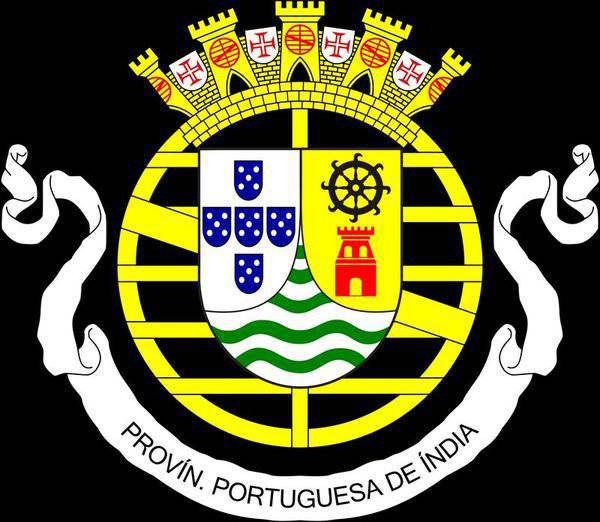
The beginning of the mass mixed marriages of the Portuguese with local women was laid by the Vice-King Afonso de Albuquerque. It was he who, destroying the male part of the Muslim population of Goa and the surrounding areas (the Hindus were not destroyed), gave the widows of dead Indian Muslims to marry soldiers of the Portuguese expeditionary forces. In this case, women were baptized. The soldiers were given plots of land and, thus, Goa formed a stratum of local population, brought up in Portuguese culture and professing Catholicism, but adapted to South Asian climatic conditions and the lifestyle of Indian society.
It was in Goa that the Portuguese “turned in” those political-administrative models that were later applied in other regions of South and Southeast Asia when the Portuguese colonies were created there. It should be noted here that, unlike the African or American colonies, the Portuguese in India faced an ancient and highly developed civilization, which had its own rich traditions of state administration, a unique religious culture. Naturally, the development of such a management model was also required, which would allow to preserve the Portuguese domination in this distant region, surrounded by the multi-million Indian population. The undoubted acquisition of the Portuguese was the existence of trade routes established over many centuries, linking Goa with the countries of Southeast Asia, the Persian Gulf and the Arabian Peninsula, and East Africa. Accordingly, a large number of experienced and trained merchants, seafarers, and shipbuilding specialists lived in Goa, which also could not but be used by the Portuguese while further expanding their colonial domination in the region.
For a long time, the Portuguese were in no hurry to abandon the administrative system that was created in the pre-colonial period, since it met the true needs of the local economy.
Despite the fact that in the 17th century, the colonial expansion of Portugal into the Indian Ocean was significantly reduced, including because of the entry of new players, the Netherlands and England, to the overseas territories and the dominance of the maritime trade in the maritime trade, a number of Indian territories were controlled by the Portuguese colonial authorities for several centuries. Goa, Dadra and Nagar-Haveli, Daman and Diu continued to be Portuguese colonies even after British India gained its independence, split into two states - India and Pakistan. Only in 1961, these territories were occupied by Indian troops.
The invasion of Indian troops into the territory of the Portuguese colonies was the final stage in the national liberation struggle of the local population, which intensified after the independence of India. Throughout 1946-1961. in Goa, protests against Portuguese domination were periodically organized. Portugal refused to transfer its territory to the Indian government, claiming that they were not colonies, but part of the Portuguese state and were founded when the Republic of India did not exist as such. In response, Indian activists launched attacks against the Portuguese administration. In 1954, the Indians actually captured the territory of Dadru and Nagar Haveli on the Gujarati coast, but the Portuguese were able to retain control over Goa for another seven years.
The Portuguese dictator Salazar was not ready to cede a colony to the Indian government, suggesting the possibility of armed resistance to annexation attempts. At the end of 1955, a Portuguese contingent of colonial troops with a total of thousands of military personnel (including Portuguese, Mozambican, and Indian soldiers and officers) was stationed in India. They consisted of 8 thousand army troops, 7 sailors, 250 police officers and 600 tax police officers who served in Goa and Daman and Diu. Naturally, this military contingent was too small to provide full resistance to the actions of the armed forces of India. 250 December 11 The Indian army, with the support of the Air Force and Navy, attacked Goa. 1961 December 19 The governor of Goa, General Manuel Antonio Vassala-i-Silva, signed the act of surrender. However, up to 1961, Portugal continued to view Goa, Daman and Diu, and Dadra and Nagar-Haveli as its legal territories, only forty years ago finally recognizing Indian sovereignty over them.
Information